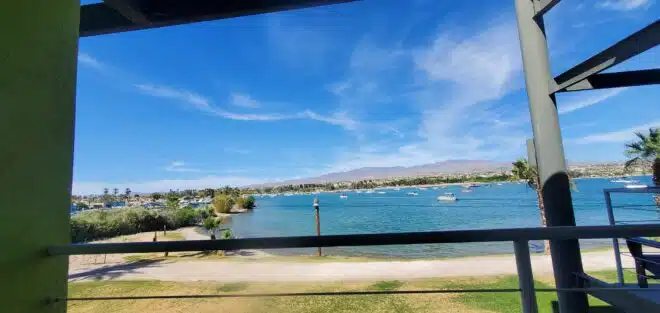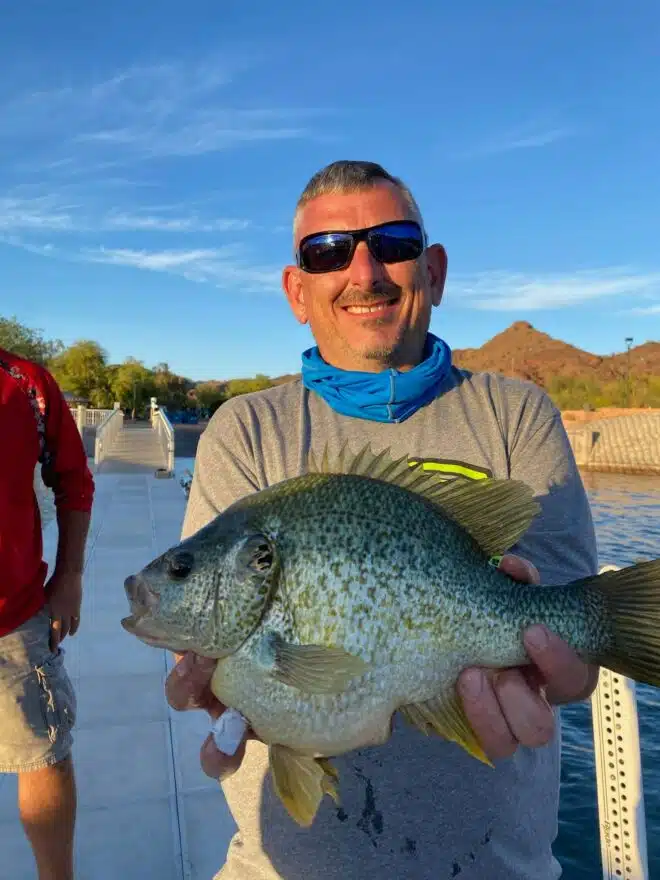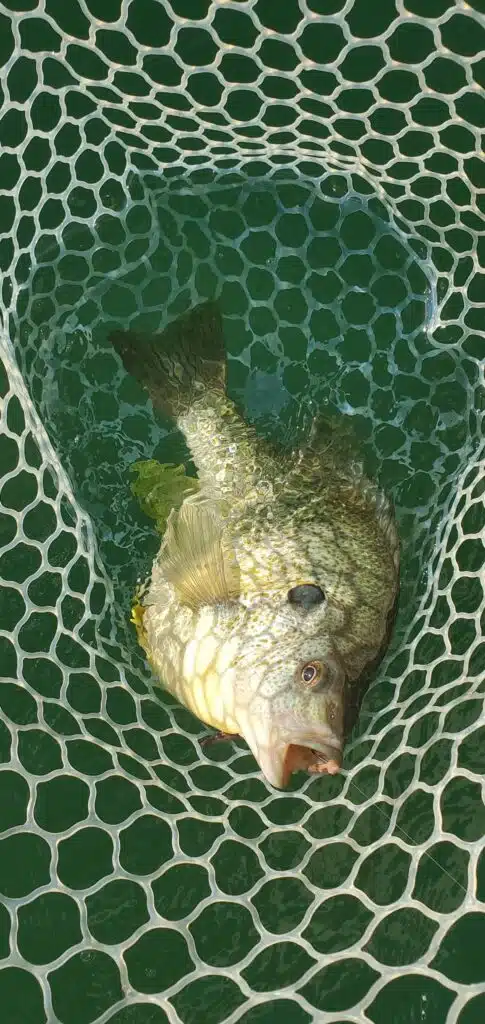Lake Havasu: A Bucket List Destination for Redear

By Greg McCain
When discussions of the ultimate fishing venues surface among anglers, clear destinations emerge in the conversation, Texas, Florida, or California for largemouth bass, the Great Lakes for smallmouth, and Mississippi for crappie.
Yet, other places fit into that category for different species, few more so than Lake Havasu, AZ. For the uninitiated, Lake Havasu is home to the world record redear sunfish. While other world records are decades old – a 4 lb.12 oz. bluegill caught in 1950 tops the charts, the Havasu records for redear are current with the most recent upgrade to the world record occurring in 2021. That giant weighed 6.30 lbs and bested the previous record, also caught on Havasu, by about a half pound.
Havasu is a 19,000-acre Colorado River reservoir on the Arizona-California border.
Among panfish aficionados, Havasu has long been an ultimate destination because of the unique circumstances that grow over-sized fish. ACC Crappie Stix owner Andy Lehman is one such person, and over the last several years, has attempted to make the trip without success. However, his plans of pursuing Havasu redear came together earlier this year, and he and a group associated with the rod company spent three days fishing for the trophy sunfish.
“It’s something that I’ve wanted to do for years,” Andy said. “The pictures that circulate on social media are incredible. The trip was something of a logistics nightmare, trying to make everything come together, the flights, the hotels, booking the guides.
“The fishing was tough, but we still saw enough there to realize the unbelievable potential that exists at Havasu.”
Added ACC pro staffer Kennieth Pierce, Fishing Ken of Hook City TV fame, “It’s a bucket list destination and definitely where dreams are made in the panfishing world.”
At the request of his boss, Rick Mendoza, Director of Sales at Desert Boiler in Las Vegas and a long-time fixture in the fishing community in southern California, helped organize the trip. Rick secured the services of local guide Nick Young through a friend, Andy Hawro, of Just 4 Fun Powersports in Lake Havasu City. Rick, admittedly more of a bass fisherman, did not know as much about the redear fishing on Havasu, but the connection with Nick ultimately made the trip successful.
“I thought you could catch them on crappie jigs just like I have fishing for crappie or bluegill,” Rick said.
“When Nick showed up at midday after a fruitless morning of fishing, we caught several fish in the afternoon. I had no idea the redear wouldn’t eat a moving bait. When we started soaking some nightcrawlers – and I mean soaking them for up to about 10 minutes – we began to catch some fish.”
Rick said the group caught perhaps 20 redears that afternoon and added to their total the next day.
“I have a new-found respect for redear,” he said. “The most difficult thing for me is that I couldn’t cast to the bass that I saw cruising under the boat. But this trip was all about targeting redear for Andy and his group.”
While none of the record-breaking redear came to the boat on the trip, plenty of quality fish that approached three pounds were caught. The biggest fish among several personal bests were identical trophy catches that weighed two lbs. 12 oz by Ken and his father, Ken Sr.
“I’m so grateful to Andy to include me and my dad on the trip,” Kennieth said. “Andy contacted me and asked if I would like to go and bring my dad along. He just turned 66, and it’s such a blessing to be able to fish with him. I’m thankful to God that he still has enough health – and me too – to be able to fish like he does.”

Another ACC pro staff member, J.P. Onhiser of Illinois, made the trip as well. He compared the waters of Lake Havasu to the gin-clear waters of the Caribbean. He said the experience was great seeing fish flash in 10-15 feet of water.
“I thought I needed a snorkel at times,” J.P. said. “That’s the only way I can describe the clarity of the water. It’s nothing like the Gulf of Mexico, more like the Caribbean.”

What makes Havasu such a unique fishery for redear? A combination of genetics and readily available food sources are primary reasons that the fish grow so large.
The genetic makeup of the fish has produced trophy redear on Havasu for years. While crawfish and freshwater shrimp are traditional food sources for redear, a more recent introduction, the invasive quagga mussels, has been present in Havasu since about 2007. The mussels grew increasingly numerous, and local fisheries biologists realized they were a perfect food for redear. As a result, the redear continue to grow to unprecedented proportions.
“There are reasons it’s No. 1 in the world,” Nick said. “The genetics here are unmatched. The world record is obviously six pounds, and there are five pounders caught every year, and numerous four pounders. We have caught several over four this year, and I think we had 11 over four pounds last year. That’s amazing. That’s unheard of.”
While the fishing is world class, Nick catches big redear, also known in other regions as shellcracker, in a simple way, the approach more the result of persistence rather than any specialized technique. Nick fishes the nighcrawler on a dropshot rig similar to those used by bass fishermen. Depending on the situation, the hook might be as small as a #6 or as large as a 1/0, the smaller version for shallow fish and the larger ones for “fishing blind.”
“It’s hard to beat a nightcrawler as a search bait for these fish,” Nick said, adding that he has a couple of brands of forward-facing sonar on his boats but that the nightcrawlers are perhaps better in finding the fish.

One reason is that the Havasu redear have become increasingly spooky due to the pressure generated by the world record catches. The pressure, plus the clear water, makes a stealthy approach a premium asset in enticing giant fish.
“A lot of times if you see the fish, it’s almost too late,” Nick said. “You really have to cast up in there to them. You might see shadows and targets, but a long cast to them is usually necessary.”
For Nick, a long cast equates to better than the 100-foot mark, a distance largely unheard of in freshwater. Larger dropshot weights up to ½-oz. help with the process.
“A long cast for me would be at the 40- to 50-yard mark,” he said. “I would say about 40 yards is it for me. We’re bombing it.”
Fishing Ken said the process was something new to him. Whether he is crappie fishing or chasing bluegills in Texas, Ken normally uses smaller lures or baits and makes short casts or even vertical jigs.
Ken said, “I kept asking myself, ‘Am I going this right?’ It’s one of those mental battles that you have to go through. Guys out there use the drop shot. I wanted to know how and why they do what they do. But I told myself that I’m at a bucket list destination and I’m going to learn how they do it.”
Labeling redear fishing as “precarious,” Nick said the fish roam from day to day. Success one day does not equal success the next, adding that the fish might be 18 inches deep out to as much as 25 regardless of the date or the stage of the spawn.
Nick exclusively uses ACC Crappie Stix for the process, supplying customers with models ranging from 6’ to 8’. His personal favorite is the two-piece 7’6” model. He once used a stiffer rod, but he said the ACC models “make it a lot more fun for my customers. All of (the different lengths) do a great job.”
He spools his reels with eight-lb. test line, which occasionally is not strong enough.
“The fight of these fish is incredible,” Nick said, adding that the bigger redear regularly take drag once hooked. “I can’t tell you the number of clients who hook into one of these fish and say, ‘Oh, I think I’ve got a bass.’ I’ll say, ‘Are you sure? Fight it out.’
“We’ve had nine breakoffs this year on eight-lb. test line, nine sunfish breaking off on eight-lb. test line due to people not fighting them correctly or the fish taking a wild run at the boat.”
Nick added that seeing a net is a trigger for the redear, comparing it to a “hawk in the air to them.” With that idea in mind, he places the net in the water well in advance of the fish coming boatside and helps his clients guide the fish into the net.
Even then, the dogged strength of the redear, characterized by “bulldogging” to the bottom and lengthy planing runs from side to side, make for some on-the-water drama for those after the bigger fish.
While Nick is happy to guide clients to big redear, he does express concern about the long-term future of the resource. The world record catches have compounded the pressure on the lake, with visitors far and wide arriving to sample the possibilities.
The pressure, especially on bedding fish, is intense.
“It’s been like night and day over the last three years, especially with the last world record being broken,” Nick said. “People are flocking here and trying to get a fish of a lifetime.”
With those ideas in mind, Nick promotes a strict boat policy while redear fishing. He practices a total catch-and-release protocol for himself and for his customers, attempting to preserve the genetic makeup of the redear population and eventually releasing the giant fish that come to his boat.
Nick’s personal best weighed four lbs. six ounces while his boat record weighed over five. Nick is passionate about preserving that type of fish.
“There is legal take here and people are allowed to do what they want,” he said, “but I am totally catch-and-release on my boat.
“We’re going to lose this No. 1 fishery in the world with people coming here and taking so many fish out. We caught fish on (the ACC trip), but it wasn’t easy. I’m on the lake seven days a week, 17 hours a day, 100 hours a week. I live with these fish, and I want to preserve them.”
After taking measurements for replica mounts, he releases the fish. Nick refers his clients to the same taxidermist who has mounted the previous world records.
For the present, the potential on Havasu is unlimited. The fish, despite the pressure, have an unlimited food supply, and fish bigger than the present world record have likely been caught and released without being weighed.
“It’s a world class fishery and unmatched,” Nick said. “If you’re seeking a personal-best redear, it’s fairly easy to get the job done especially with someone experienced on the lake.”

Nick guides on Havasu for largemouth and smallmouth bass, striper, and redear from Oct. 1 through the last days of May. Contact him at Nick Young Outdoors (541.709.1542 for Nick or 541.709.4628 for booking a trip) for a trip later this year or for the 2024 redear season, which typically runs March, April, and May. Booking well in advance is advised.
Nick, emphasizing the family-friendly nature of many of his trips, also guides on Clear Lake, CA, in late May and through June for trophy largemouth bass and crappie. He then spends several months on the Oregon coast, fishing around the mouth of the Rogue River, for king salmon.













